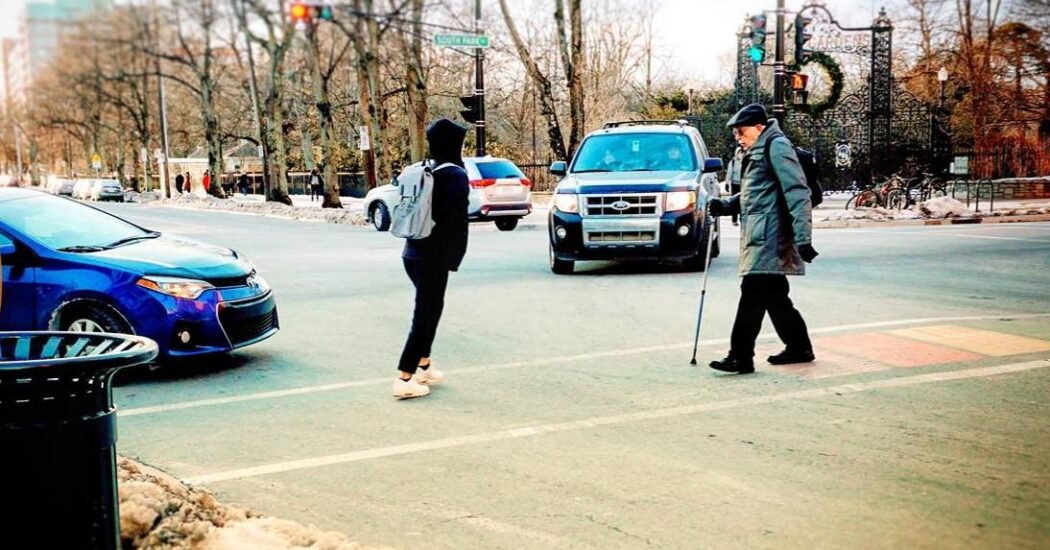
Letter to the Halifax Accessibility Advisory Committee and the Halifax Transportation Standing Committee
Dear All,
I’ve been involved for some time in a completely voluntary capacity with safe streets issues in Halifax, particularly relating to pedestrians.
A key concern is lack of safety for pedestrians at signalized intersection crosswalks, which from data collected over 6 years in HRM account for 40% of all incidents where pedestrians are hit.
The most common cause of incidents arise from left turns on a green light, as can be seen from page four of the linked HRM pedestrian safety report above.
Canada is often cited in international research as experiencing very high proportions of pedestrian incidents at signalized intersections – accounting for a staggering 76% of all pedestrian incidents in Toronto. The hazard caused by combining vehicle turning and pedestrian movements at the same time is discussed in more detail in this article.
Signalized intersections can be a safe place for pedestrians to cross the road. Other countries throughout Europe, also (to my knowledge from visits) cities in Asia and South America do not combine vehicle movements with pedestrian movements – traffic is prevented from turning with a red light while pedestrians cross. Cities and towns in the UK utilize a simple four-red signal phase – pedestrians cross at the same time on all crosswalks (but not diagonally, as for a “scramble” intersection) while traffic is stopped in all directions. This requires only adjustments to traffic light timings, no physical/structural changes.
Last month, two pedestrians were struck by a driver turning left on green at an intersection in Bedford. The man was left with life threatening injuries.
Earlier this year, an elderly lady was struck and killed by a driver turning right on green on Portland Street.
Turning movements and traffic signals in the above two incidents were confirmed to me by police and traffic staff.
I am extremely concerned that we continue to place vulnerable road users at great risk by dangerous signal timing configurations that invite conflict and confusion. From conversing with local people in Halifax with disabilities, I understand that turning traffic while the walk sign is on is an impossible danger for those with a visual disability to contend with. People with physical disabilities (and the elderly) are unable or less able to turn their body and head to spot turning traffic, which in the case of right turns on greens and reds often comes from behind you as you begin crossing.
From the limited data available, it seems wheelchair and electric mobility scooter users are often struck at signalized intersections by turning drivers – see for example page 8 of this report on pedestrian incidents in 2012.
I understand that traffic staff have not completed any driver yield testing at signalized intersections. Given the incident data and absence of any safety testing, it seems we do not know if they are safe to use. The presumption given the research, data for Halifax and other cities in Canada is that they are not.
There is no current strategy for dealing with this public safety issue to my knowledge. A limited number of intersections have what is referred to as a “leading pedestrian interval (LPI)” – a safety countermeasure which provides a few second head start for pedestrians on turning traffic. Extensive testing throughout the US by the Federal Highways Authority has shown that this reliably reduces incidents by just 13%. In Halifax, pedestrians have continued to be struck by drivers turning left on a green at locations with a LPI. Given the very significant number of serious incidents, a 13% reduction is not enough.
My own communication with traffic staff regarding this danger at specific locations has not resulted in any remedial action. The most useful communication I have received was provided by a provincial traffic-light designer who explained how traffic lights can be adapted to ensure pedestrians are protected from traffic when they cross, including for the four red-phase mentioned above. HRM staff have not provided much information other than it would require “significant physical changes” and that the impact on traffic would need to be assessed.
The danger caused by turning traffic at signalized intersections cannot be easily mitigated by either pedestrian or driver care due to the complexity of the manoeuvre, as outlined in research. In this 2013 study from Oregon State University researchers found an “alarming” level of risk to pedestrians. Despite these findings, we have not addressed this known danger.
This is not an issue where engineers may balance the cost to vulnerable road user lives against the benefit gained to traffic flow. It is a human rights issue that requires urgent action and intervention by leadership through appropriate policy.
The danger isn’t confined to areas where there are higher numbers of pedestrians, such as downtown Halifax and Dartmouth. It affects everyone who uses our signalized intersection crosswalks, including suburbs where they are often used by people with disabilities, schoolchildren and the elderly.
I am writing to request the following actions are initiated:
1. You request that pedestrian incident records show how many of those struck have a disability, and if so what type of disability.
2. You request an engineering study is commissioned urgently by specialist and external experts to examine this safety issue at signalized intersections in HRM, also what permitted remedial measures can be implemented within provincial legal requirements. Such a report can be used to compliment and evaluate any measures or remedies that may be identified in future by our own staff.
3. You propose a consultation-led report is initiated which can inform us what issues are faced by people with disabilities on our crosswalks, and how any issues identified could be resolved.
I would be very happy to provide any further information relating to this request.
I will send the same email to the Transportation Standing Committee in case it is better suited to their consideration.
I hope you do not object to this request being shared with the public, given the very significant public interest and safety issues raised.
With best wishes
Martyn Williams
If you walk, cycle or use a wheelchair and are affected by road safety issues, please join HRM Safe Streets for Everyone. If your local crosswalk needs a crosswalk flag, please contact the Crosswalk Safety Society. Please remember to report issues affecting your safety to our municipal authorities using the 311 service.
With a special thanks to our generous donors who make publication of the Nova Scotia Advocate possible.
Subscribe to the Nova Scotia Advocate weekly digest and never miss an article again. It’s free!




Bravo! The safety of pedestrians, especially the vulnerable, should be paramount. Having drivers stop for a few seconds in order to save lives is not only fair, but should be the obvious thing to do.